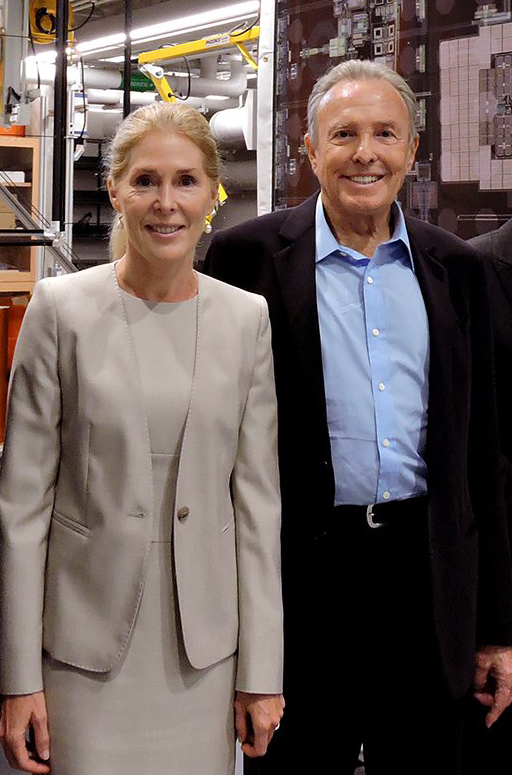Among Donald Bren’s fondest childhood memories are the weekends on Lido Isle, a man-made jewel on the Orange County coast. He’d trek down from the Westside with his best friend’s family and spend long hours rowing in Newport Harbor.
As Bren reminisced nearly seven decades later, he turned to the floor-to-ceiling view from his ninth-floor conference room, taking in Fashion Island, Newport Harbor, Lido Island and the shimmering blue Pacific.
“Long story short,” he said, smiling, “I didn’t go very far.”
Today, Bren is the sole shareholder of Irvine Co., one of the most successful real estate firms in U.S. history, owner of the Irvine Ranch and more than 600 premium office buildings, shopping centers, apartment communities and resort properties. He’s also Southern California’s wealthiest man and America’s richest land developer, with a net worth Forbes estimates at $12 billion, twice that of Eli Broad.
At age 78, he has begun to talk openly about a reality with far-reaching implications: that, one day, all of this will be owned and run by someone else.
In a series of recent conversations, Bren said he has made plans for Irvine Co. to continue as a private company controlled by its independent board of directors, which will choose a new chairman. The beneficiaries, he says, will be a combination of public and private entities, which he declined to specify.
“This is a private company that is set up to operate in perpetuity,” he said.
Bren has been more than just the owner; for more than three decades, he’s been its entrepreneurial heart.
“Clearly, Donald Bren is the Irvine Co. and the Irvine Co. is Donald Bren,” said John Cushman, chairman of the commercial real estate brokerage Cushman & Wakefield. Imagining the firm without Bren, he added, is akin to pondering what Berkshire Hathaway will be without Warren Buffett.
Over the years, Bren has sculpted the look of modern suburbia in California and, in the process, become one of the country’s largest and most-copied developers of planned communities.
He’s also preserved and donated to the public more acres of California’s open spaces than he has developed, including 20,000 acres of pristine wilderness that he gave to Orange County last year, asking only that it remain open space forever. (“It’s all yours,” he told the parks chief at the ceremony, where he also donated money to help manage it.)
Along the way, Bren has given away $1.3 billion of his fortune, much of it to bolster education, including millions to public school arts and science programs and $200 million to the University of California.
“In terms of great visionaries who have influenced Southern California, I’d put him up there with Walt Disney,” said Rick Caruso, who owns the Grove and other shopping meccas and is a member of the Irvine Co. board.
These days, Bren remains focused on running his company. He dresses in a suit and tie and drives himself to work for a full day of meetings with colleagues, and leaves each evening with a briefcase stuffed full of what he calls “my homework,” articles on history or science that have caught his eye as well as drawings and plans for Irvine Co. properties.
Sometimes, he’ll sit at his home drafting table at night, studying designs for houses, office buildings, shopping centers or resorts.
“He’ll blow in the next morning with a whole wad of tracing paper and overlap drawings for all of our projects,” said Robert Elliott, senior vice president in charge of the 23-person design team. “It’s amazing, because hardly anybody draws anymore. But he draws very well.”
The corporate ethos reflects Bren’s personality, a mix of self-discipline, creativity and entrepreneurship salted with an abiding thirst for knowledge.
But the man who runs this influential company is something of a mystery. He doesn’t like to talk about himself and limits his outside engagements. Those kinds of things, he said, “take focus and energy away from the challenges required to build a new city. I do limit my exposure to the public. You only have so much time.”
Bren looks years younger than his age, with a ruggedly handsome face and the sturdy frame of an athlete. He was a top-flight downhill skier as a young man, and attended the University of Washington on an athletic scholarship. He missed a chance to make the 1956 Olympic team when he broke his ankle in a fall on the slopes.
Bren, his wife, Brigitte, a 45-year-old lawyer, and their 7-year-old son spend many weekends at their ranch in Sun Valley, Idaho, where Bren still tackles the black diamond runs.
Former Baseball Commissioner Peter Ueberroth and his wife, Ginny, have joined the family for sailing vacations on the Mediterranean, but they draw the line at the winter slopes. “We don’t ski well enough to keep up with Don and Brigitte,” he said with a laugh.
The Brens, who’ve been married for 12 years, have a home in West Los Angeles, where they enjoy dining with close friends, including former Gov. Pete Wilson and his wife, Gayle. But the Brens spend most of their time at their waterfront villa on tiny Harbor Island, an exclusive neighborhood just a seven-minute drive from corporate headquarters.
Bren’s home is designed in the style of Andrea Palladio, the 16th-century Renaissance architect whose influence is evident in the Pelican Hill Resort and other Irvine Co. properties. A student of architecture and history, Bren was inspired by Palladio’s famous treatise, “The Four Books of Architecture.”
“He’s probably the most influential architect in the history of the modern world,” Bren said. “I’m just in love with his designs.”
Bren and his wife are Republicans, and he describes himself as “a fiscal conservative and social moderate.” He backed Wilson’s Senate campaign and contributed to Meg Whitman’s gubernatorial bid. But he’s also long supported Democrat Dianne Feinstein, whom he calls “a great senator for California.”
Bren has worked diligently to keep his personal life private. He has six children, including one with Brigitte and three from his first two marriages.
The two other children, now 18 and 22, were with a former girlfriend. They battled Bren in court last year seeking $130 million in retroactive child support. Bren testified during the trial, and his attorneys noted that he had given the children more than $9 million since their birth and, although he rarely saw them, had already promised to pay their education expenses until the age of 25. The jury sided with Bren.
His two oldest sons are in the real estate business, though neither works for Irvine Co. “The best way for a young person to grow and prosper is on his own, as I did,” Bren said.
Bren grew up in Bel-Air and later Beverly Hills, and graduated with the Beverly Hills High class of 1950. His father, Milton Bren, was a real estate investor and Hollywood film producer best known for the “Topper” screwball comedies of the 1930s and ’40s.
His parents divorced when Donald and his brother were young, and their father married the film noir actress Claire Trevor in 1948, the year of her Oscar-winning turnin “Key Largo.”
Trevor earned fame playing tough dames, though off-screen she was an intellectual, an accomplished painter and sculptor, and a friend of artists, particularly the 1950s-era abstract expressionists known as the New York School. She introduced Bren to many of those artists, and her appreciation for art had a profound effect on her stepson.
“That was such an exciting period,” Bren recalled. “What I learned from Claire was to see a different dimension, the depth, the symmetry, the relationships, the color. That carried over to architecture for me.”
Bren, who sits on the board of the Los Angeles County Museum of Art, describes himself as a modest collector. Paintings by the late Richard Diebenkorn, a California artist and one of Bren’s favorites, hang in the Bren home and at Irvine Co. headquarters.
Bren earned a degree in business and economics at UW, then entered the Marines as an infantry officer after the Korean War, leaving with the rank of first lieutenant. The discipline “was a rude awakening after college life,” he recalled with a laugh. But it’s something he still values, and he regularly attends the Marines’ birthday celebration in Orange County.
After his discharge, Bren considered law school. But on a return visit to Newport Beach he spotted a waterfront lot for sale on Lido Isle, the same place he’d played as a youngster. He borrowed $10,000 from a friend at a bank, a little more from an acquaintance at a savings and loan, and became a home builder.
Bren Co. grew quickly in the post-World War II boom, developing a reputation for attractive designs and quality construction. He developed the first master plan for 10,000 acres in Mission Viejo, building homes, a shopping center and a golf course, and was erecting thousands of homes a year across California.
In 1977 he took the fateful gamble of buying a controlling interest in Irvine Co. with two other investors.
The company’s signature property was the Irvine Ranch, 93,000 acres that stretched from Newport Beach to the Cleveland National Forest, five times the size of Manhattan and one-fifth of Orange County. The ranch was named for James Irvine, an Irish immigrant who pieced together Spanish and Mexican land grants during the Lincoln presidency.
When the housing market stalled in the early 1980s, Bren made a move that touched off one of the biggest legal battles in the history of Orange County.
It began when Bren borrowed $560 million and bought out his partners. Then he moved to acquire the final shares from Irvine family members, including James Irvine’s great-granddaughter Joan Irvine Smith. She contended that Bren had grossly underpaid for the company, and their years-long legal fight ultimately cost more than $30 million. In the end, a court mediator settled the case and Bren paid Smith $240 million, or less than half what she had sought.
By 1991, he was the sole owner of a stunning property that lay squarely in the path of an explosion of suburban growth south of Los Angeles.
Irvine Co. had taken initial steps to create the master plan for the city of Irvine and set aside land for public spaces, but after Bren took over, he greatly expanded those efforts.
Bren’s swift moves and his company’s growing power spawned enemies in those years. Environmentalists were suspicious of his promises to leave large parts of the ranch untouched. Others accused the company of transforming vast swaths of the ranch into bland suburban developments.
But, today, Bren has won over many of his critics. When he donated the wilderness acres to Orange County last year, environmentalists praised him. Jean Watt, president of the nonprofit Friends of Harbors, Beaches and Parks, hailed it as “a new era of cooperation.”
Even Larry Agran, the former mayor of the city of Irvine who for years was a Bren critic, has come around. “What the pioneers of the Irvine Co. understood, and what Bren and the company have come to realize, is that planning really works,” he said.
The city of Irvine, population 217,000, is about 85% developed, with a 20-year supply of residential lots remaining. It has a median home value of $600,000 and acres of space devoted to parks, community buildings, sports fields and green belts.
The Irvine Co. vision, that a community with plenty of open spaces would make the private development all the more profitable, has paid off. Last year, while builders everywhere struggled to get off the mat, Irvine Co. restarted its dormant home-construction division and has since sold 1,200 homes there.
Today, Irvine Co.’s suburban juggernaut covers 44,000 acres of the ranch, and nearly half the rest is a natural habitat with a National Natural Landmark designation, home to mountain lions, golden eagles and dozens of species of rare and endangered plants and animals.
“I’ve heard people say he only protected it because it couldn’t be developed. But they either haven’t seen it or haven’t seen what developers can do in Southern California,” said Michael O’Connell, a conservation biologist who heads the Irvine Ranch Conservancy. “He could have developed it all.”
The company’s reach now extends well beyond the ranch. It has commercial, retail, residential and resort holdings in Los Angeles, San Diego and Silicon Valley, 95 million square feet of investment property in all. A few months ago, it bought the 5-year-old Hyatt Center, an elliptical 48-story office tower in Chicago.
Irvine Co. doesn’t release financial details, but it holds the highest credit rating, with a debt load about half of its competitors’; most of its office and retail properties, and all of its land, are debt-free.
For more than a quarter-century, the key to Irvine Co.’s success has been Bren. He plans to lead the company as long as he’s able.
But, when the time comes, Bren says, the company board, which now includes Caruso, Ueberroth and Wilson, will select a new leader, most likely from Bren’s four-member “office of the chairman,” the top lieutenants who work with him to chart the company’s future.
“No one lives forever,” said Daniel Young, a five-term Santa Ana mayor who heads the company’s community planning and development division and is one of those top executives. “But there’s a system in place and a great board in place.”
Bren carefully chose his words when speaking about that future.
“The Irvine Co. doesn’t end with me,” he said. “I’m just here for a period. The company goes on.”

Scott Kraft
Los Angeles Times











